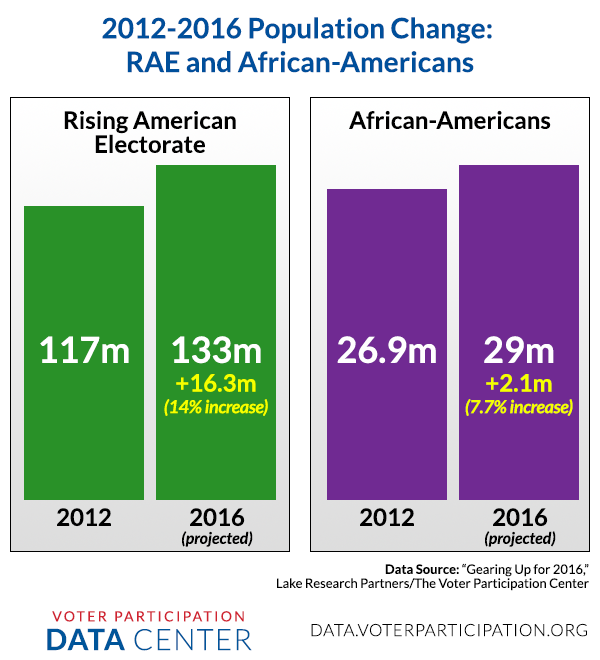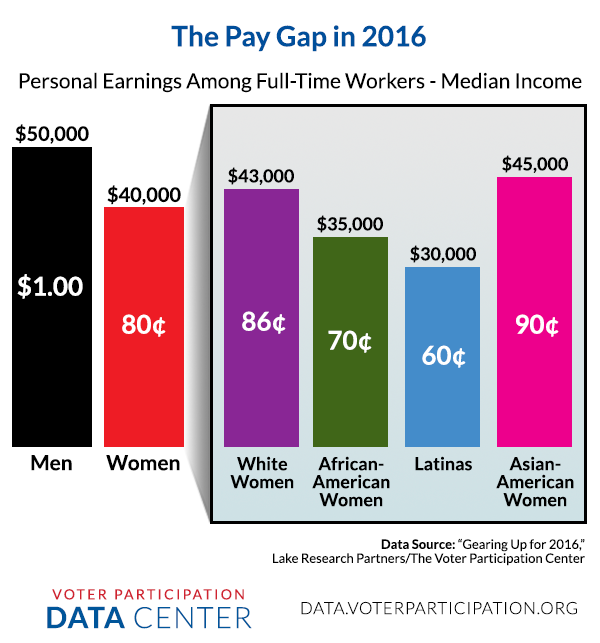The Rising American Electorate on Super Tuesday
On Tuesday, March 1, 2016, the largest number of states will hold primaries or caucuses. Super Tuesday states this year include: Alabama, Alaska (Republican caucuses), Arkansas, Colorado (caucuses), Georgia, Massachusetts, Minnesota (caucuses), Oklahoma, Tennessee, Texas, Vermont, Virginia, and Wyoming (Republican caucuses).
In most presidential years, Super Tuesday is a turning point, serving as a major indicator of who the nominees will be from each party. It is the biggest single-day opportunity for presidential candidates to receive delegates.
What’s at stake? In all, 595 Republican delegates—a little less than half of the 1,237 delegates required to win the GOP nomination—will be available on Super Tuesday. On the Democratic side, about 1,004 delegates will be available on March 1, out of the 2,383 delegates a candidate will need to win the nomination.
The participation of the Rising American Electorate (RAE)—unmarried women, people of color and millennials—has the potential to dramatically affect outcomes in several states where they make up a large percentage of eligible voters:
- In Texas, GOP candidate Senator Ted Cruz’s home state, the RAE makes up 66% of eligible voters, but as of November 2014 only 52% of the RAE were registered to vote. 46% of the eligible voters in Texas are people of color; 29% are 35 or younger.
- In Georgia, 62% of the eligible voters are either unmarried women, people of color or millennials. 59% of them are registered to vote. 39% of the state’s eligible voters are people of color.
- In Alaska, 61% of the state’s eligible voters are members of the RAE; 62% of the RAE are registered to vote. People of color make up 38% of the state’s eligible voters.
- In Alabama, the RAE makes up 56% of the eligible voters; 62% of the RAE are registered to vote. 30% of eligible voters in Alabama are people of color.
- In Virginia, 56% of eligible voters are RAE members; 59% of the RAE are registered to vote. 30% of eligible voters are people of color.
Unmarried women make up at least a quarter of the eligible voters in these Super Tuesday states: Alabama (27%), Arkansas (25%), Georgia (27%), Massachusetts (27%), Minnesota (25%), Oklahoma (25%), Tennessee (27%), Texas (26%), and Vermont (25%).
Learn more about unmarried women in the Super Tuesday states:
|
Alabama Alaska Arkansas Colorado |
Georgia Massachusetts Minnesota |
Oklahoma Tennessee Texas |
Vermont Virginia Wyoming |
The Rising American Electorate in South Carolina and Nevada
The stories out of Iowa and New Hampshire focused on the participation levels, voting preferences, and burgeoning political power of millennial voters. But as the presidential contests move west to Nevada and south to South Carolina, the electorates begin to look more like the national body of voters. The coming contests will be more accurate tests of the power and influence of young voters and the rest of the Rising American Electorate (RAE).
Nationally, the RAE—which is comprised of millennials (voters 35 and younger), unmarried women, and people of color—make up the majority, close to 57 percent, of all eligible voters.
In South Carolina, that combination of voters makes up exactly 57 percent of the vote-eligible population:
- Unmarried women make up 27 percent of eligible voters;
- Millennials make up 27 percent; and
- African-Americans make up 26 percent.
And what’s the overlap between these demographic groups?
- 38.7 percent of all millennials in South Carolina are unmarried women;
- 32.6 percent of eligible African-American voters are 35 or younger; and
- 31.7 percent of millennials in the state are unmarried African-American women.
In Nevada, the RAE accounts for 62 percent of eligible voters, meaning their influence over the caucus outcomes could be significant.
- Unmarried women make up 26 percent of eligible voters;
- Millennials make up 28 percent; and
- Latinos account for 19 percent of all eligible voters in the state.
The overlap?
- 26.5 percent of voters 35 and younger (millennials) in Nevada are unmarried women.
- 27.6 percent of millennials are Latino; and,
- 16.5 percent of millennials are unmarried Latina women.
Statistical Profile of Unmarried Women: Nebraska
Our research team has compiled available data from the US Census Bureau, the Bureau of Labor Statistics, and other sources to put together this statistical profile of the demographic and economic circumstances facing unmarried women in the state of Nebraska.
Downloads
Statistical Profile of Unmarried Women: Maine
Our research team has compiled available data from the US Census Bureau, the Bureau of Labor Statistics, and other sources to put together this statistical profile of the demographic and economic circumstances facing unmarried women in the state of Maine.
Report updated June 2017
Downloads
Statistical Profile of Unmarried Women: Louisiana
Our research team has compiled available data from the US Census Bureau, the Bureau of Labor Statistics, and other sources to put together this statistical profile of the demographic and economic circumstances facing unmarried women in the state of Louisiana.
Downloads
Statistical Profile of Unmarried Women: Hawaii
Our research team has compiled available data from the US Census Bureau, the Bureau of Labor Statistics, and other sources to put together this statistical profile of the demographic and economic circumstances facing unmarried women in the state of Hawaii.
Downloads
Statistical Profile of Unmarried Women: Kansas
Our research team has compiled available data from the US Census Bureau, the Bureau of Labor Statistics, and other sources to put together this statistical profile of the demographic and economic circumstances facing unmarried women in the state of Kansas.
Downloads
RAE Spotlight: African-American Voters
During Black History Month, we thought it would be a good time to take a deeper look at a key segment of the Rising American Electorate (RAE)—African-American voters.
- Nine out of ten African-Americans voted for Barack Obama in 20121, and the coalition behind President Obama’s victories in 2008 and 2012 is still intact and growing.


Notes
1. Greenberg Quinlan Rosner Research, Democracy Corps, and Women’s Voices Women Vote Action Fund. ”How unmarried women, youth and people of color defined this election,” 19 November 2012. Slide 33.
2. Lake Research Partners/The Voter Participation Center. “Gearing Up for 2016,” updated 25 September 2015. Slide 13.
3. Lake Research Partners/The Voter Participation Center. “Gearing Up for 2016,” updated 25 September 2015. Slide 61.
2016 Primary Spotlight: South Carolina and Nevada
The voices of more racially-diverse Presidential voters will be heard starting Feb. 20, 23, and 27 with the South Carolina primaries and Nevada caucuses. For the first time this primary season, the Rising American Electorate (RAE)—the population of unmarried women, people of color, and millennials—in South Carolina and Nevada make up the overwhelming majority of eligible voters, just as they do nationally.
The RAE makes up close to 57 (56.7%) percent of eligible voters in U.S. In Iowa, the RAE made up 45 percent of eligible voters and just 41 percent in New Hampshire. But in South Carolina, the RAE makes up 57 percent of eligible voters in the state; they make up 62 percent in Nevada.
South Carolina
The South Carolina primaries are the “first in the South” primaries for both parties. The Republican primary will be held on February 20; the Democrats will vote on February 27. Historically, these key early primaries have helped narrow the field of both Democratic and Republican contenders. The state does not have registration by party. Voters may vote in either party’s primary, but not in both.
South Carolina’s primary is the first contest in which a large percentage of the electorate will be African American. People of color make up 31 percent of the eligible voters in South Carolina. 65 percent of those eligible voters are registered to vote; 35 percent are not.
Unmarried women in South Carolina make up 27 percent of the eligible voters:
- Women make up more than half of South Carolina’s population (53%)
- There are more unmarried women (51.3%) than married women (48.7%) in the state.
- 5 percent of unmarried women in South Carolina are African-American.
- 64 percent of unmarried women are registered to vote.
A detailed demographic analysis from the Voter Participation Data Center shows that unmarried women have a large and vital economic stake in the outcome of the presidential election:
- Unmarried women have the highest unemployment rate in the state: 9.9%. They are more than two and a half times more likely to be unemployed than married women (3.7%).
- Unmarried women earn less than married women. Married women in South Carolina earn close to what a man earns (93.8%); unmarried women lag behind making 81.4 percent of what a man earns in the Palmetto State.
- More than a quarter of unmarried women in South Carolina live in poverty and unmarried women are more than 3 times as likely to live in poverty (25.8%) than married women (8.0%).
- About six in ten of all minimum wage or below-minimum wage workers in South Carolina are women.
Nevada
Nevada’s Democratic caucus is scheduled for February 20; the GOP caucus is set for February 23. Nevada is the first state in the West to vote, the first primarily labor-based state to vote, and the first state with a significant Hispanic population to vote. Close to one in five (18.9%) of Nevada’s eligible voters is Hispanic. Fifty-four percent of eligible Hispanic voters in Nevada are registered to vote; 46 percent are not.
Anyone who will be 18 years old at the time of the Nov. 8 general election is eligible to participate in the caucuses, including high school students. The caucus is a partisan process; people who want to participate must be registered as a member of the party. Democrats have same-day registration while Republicans require voters to register by Feb. 13.
Unmarried women make up 26 percent of Nevada’s eligible voters.
- There are close to equal numbers of men and women in Nevada. Women make up 50.3% of Nevada’s population; men make up 49.7%.
- There are more unmarried women (51.6%) than married women (48.4%) in the state.
- More than a quarter of Hispanics are unmarried women (25.6%).
- 55 percent of unmarried women are registered to vote.
An economic profile from the Voter Participation Data Center makes it clear unmarried women have a lot riding on the outcome of the presidential election:
- Unmarried women have the highest unemployment rate in the state (11.5%). They are more than four times more likely to be unemployed than married women (2.6%)
- Unmarried women earn less than married women. Married women in Nevada earn 82.5% of what a man earns; unmarried women make 76.8% of what a man earns in the Palmetto State.
- More than a fifth of unmarried women in Nevada live in poverty and unmarried women are more than almost 3 times as likely to live in poverty (21.3%) than married women (7.7%).
Next: Super Tuesday, March 1
Statistical Profile of Unmarried Women: Wyoming
Our research team has compiled available data from the US Census Bureau, the Bureau of Labor Statistics, and other sources to put together this statistical profile of the demographic and economic circumstances facing unmarried women in the state of Wyoming.

